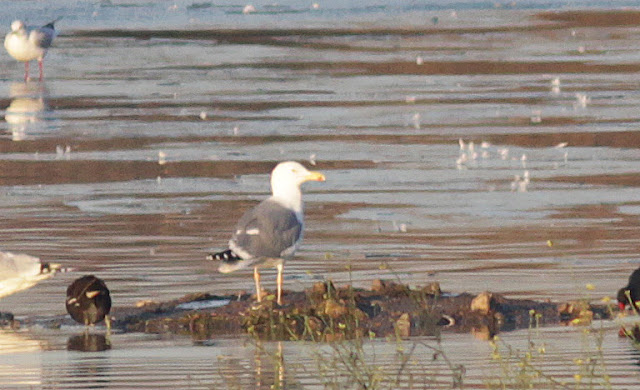Started off the day looking for Barn Owl pellets with Tomos. The nest site (we had a breeding pair this year!) was very clean but we did find what must be a roost site with plenty of pellets. Marcus also says he found some in the Storm Tanks. With three young and the adults presumably there are at least five birds in the area (assuming no mortality yet). Hoping to go owling on Sunday night and will dissect some of the pellets asap.
Went under the tunnel and counted the hibernating Herald moths before heading over to join the gang on the viewing mound looking at the gulls.
Polish ringed Caspian Gull or Caspian Gull hybrid. Pic by Kojak Kojak's blog
'Second winter Caspian-type'
Caspian looking Yellow-legged Gull. The anaemic looking leg colour and rangy structure suggests something not straight forward
Wing-tip pattern reveals extensive dark in wing tip closer to Yellow-legged Gull. (same bird as above)
First-winter Common Gull (canus). Following on from Peter Adraiens and Chris Gibbins recent paper on Common Gull complex identification in Dutch Birding, hoping to find a 'Russian Common Gull' (heinei) at the farmlands. The most distinctive feature to look out for on one is a completely white head with a dark streaked boa- a bit like a mini- Caspian Gull head (unlike the streaked nape and crown of this bird)
Heavily marked juvenile/first-winter Common Gull (canus)
Second winter Common Gull. Using the key on pg 25 of DB 38:1; p9 outer web with all black base, p4 with one black spot on one web only= canus.
Adult Common Gull. Using key on pg 18 of DB 38:1. p9 without obvious white tongue-tip, p5 with broken black band, p7 with white tongue tip, p8 with grey at base of outer web, p9 with large mirror (larger than black tip) = canus
Gulls over Croydon
Adult male Wigeon (right) with extensive white in coverts and two first-winter males with reduced white
Red Kite over the viewing platform today (with an unusual extensively white head)
Heralds in the tunnel. Tomos and I counted 23.













No comments:
Post a Comment